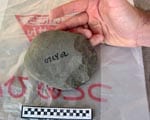Book a live interview

To book a live or taped interview with Peter Weyand in the SMU News Broadcast Studio call SMU News at 214-768-7650 or email news@smu.edu. |
Related links
- Peter Weyand
- Journal of Applied Physiology: “The biological limits to running speed are imposed from the ground up”
- Annette Caldwell Simmons School of Education & Human Development
More SMU Research news
The New York Times tapped the expertise of SMU’s Peter Weyand, an expert in human locomotion, in an Aug. 8 article “As Debate Goes On, Amputee Will Break Barrier”
Journalist Juliet Macur examines the controversy surrounding double-amputee sprinter Oscar Pistorius. Preparing now for the 2012 London Olympics, the 24-year-old South African once again is under the spotlight for his controversial carbon-fiber prosthetic legs that attach just below his knees.
Weyand is widely quoted in the press for his expertise on human speed. He led a team of scientists who are experts in biomechanics and physiology in conducting experiments on Oscar Pistorius and the mechanics of his racing ability. Pistorius has made headlines worldwide trying to qualify for races against runners with intact limbs, including the Olympics.
Weyand is an SMU associate professor of applied physiology and biomechanics in the Annette Caldwell Simmons School of Education & Human Development.
EXCERPT:
By Juliet Macur
The New York Times
The moment that the sprinter Oscar Pistorius had hoped for and trained for finally came Monday when he was named to South Africa’s team for the track and field world championships, which will make him the first amputee to compete at the event.“If I manage to make it through the heats, I would be thrilled.” Oscar Pistorius, on qualifying for the world championships.
Pistorius, a four-time Paralympic champion, will race in the 400 meters and the 4×400 relay against men who have two natural legs, while he uses prosthetics. Last month, he ran fast enough to meet the Olympic qualifying standard, and now he will blaze a trail.
“This will be the highest-profile and most prestigious able-bodied event which I have ever competed in, and I will face the highest caliber of athletes from across the planet,” Pistorius, 24, said in a statement sent Monday by his agent, Peet van Zyl. “If I manage to make it through the heats, I would be thrilled.”
The road to the world championships could just lead to a berth in the 2012 London Games for Pistorius, who said he had never considered himself disabled and had never considered the world championships or Olympics out of his reach.
Even so, that road to making the team for this month’s world championships, which will begin Aug. 27 in Daegu, South Korea, has not been smooth for Pistorius — and his road to the Olympics may not be any smoother.
Born without his fibulas, the long bones that span from the knees to the ankles, Pistorius relies on carbon-fiber prosthetic limbs to propel him around the track in times comparable to some of the world’s top runners. And therein remains the question that has been the crux of a continuing debate: do those high-tech legs give him an unfair advantage?
In 2008, the International Association of Athletics Federations, track and field’s governing body, thought so. It ruled that Pistorius was ineligible to compete in the worlds because his prosthetic legs made it easier for him to run than competitors with legs made of flesh and bone. But he appealed to the Court of Arbitration for Sport and won in May 2008.
The court, though, provided no definitive answer to the underlying question of whether Pistorius was naturally fast or just fast because of his prosthetic legs. It said that the I.A.A.F. failed to meet its burden of proving that Pistorius’s legs provided him with an overall advantage or disadvantage.
To further complicate the issue, the court made it clear that the case could be reopened, saying that advances in technology and a different testing regime might prove that Pistorious’s legs did, in fact, give him an edge.
“There was a disagreement among the scientists, but I feel that the conclusion was overwhelming that he’s a lot faster with the legs than someone is without them,” said Peter Weyand, an associate professor of applied physiology and biomechanics at Southern Methodist University and one of seven scientists who in 2008 conducted physiological and biomechanical tests on Pistorius at Rice University.
SMU is a nationally ranked private university in Dallas founded 100 years ago. Today, SMU enrolls nearly 11,000 students who benefit from the academic opportunities and international reach of seven degree-granting schools. For more information see www.smu.edu.
SMU has an uplink facility located on campus for live TV, radio, or online interviews. To speak with an SMU expert or book an SMU guest in the studio, call SMU News & Communications at 214-768-7650.
By Margaret Allen
Senior research writer, SMU Public Affairs
View Archive → The New York Times tapped the expertise of SMU’s
The New York Times tapped the expertise of SMU’s 





